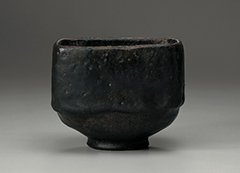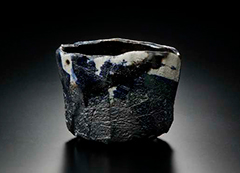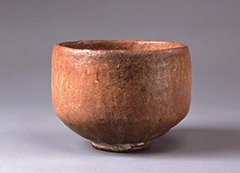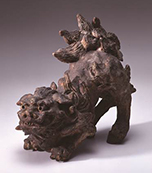Raku: The Cosmos in a Tea Bowl Exhibition to be held at the two major Russian museums, The State Hermitage Museum and The Pushkin State Museum of Fine Arts from July.
The Japan Foundation and the Raku Museum jointly organize Raku: The Cosmos in a Tea Bowl at two major Russian museums, the Hermitage Museum and the Pushkin State Museum of Fine Arts from July. The exhibition has received many good reviews while being held at the Los Angeles County Museum of Art held between March and June this year.
At the exhibitions in Russia, Important Cultural Properties, including Chōjirō’s Two-colour glazed lion sculpture (Raku Museum), Black Raku tea bowl named Mukiguri (Agency for Cultural Affairs) and Red Raku tea bowl named Muichibutsu (Egawa Museum of Art) are shown.Featuring work by past Raku masters and by the brilliant Hon’ami Kōetsu, a close associate, as well as the wide-ranging activities (not limited to ceramics) of the current master Raku Kichizaemon XV and pieces by his son Atsundo, the future family head, this exhibition is a comprehensive survey of the unique aesthetic and philosophical realm of Raku ware, providing fascinating glimpses into each of the eras it covers. In addition, finely decorative paintings, including Scenes in and around Kyoto, are shown, to present the period background of founding Raku ware.
This exhibition presents approximately 170 works, from the serene, monochromatic tea bowls of founder Chōjirō, which most directly reflect the wabi tea ceremony ideals of legendary tea master Sen no Rikyū, to the strikingly original innovations of the current Raku master as well as the paintings from the same period. We are confident that this first full-fledged show of Raku ceramics in the Russia will draw much attention and acclaim.
Please see the webpage for the details on the exhibition in Los Angeles.
In conjunction with the exhibition, Kongo School Noh Performance is organized at the State Hermitage Museum and the Moscow Theater Center “Vishneviy Sad.” Please see the detailed information.
Read an essay, written by Raku Atsundo, on the exhibitions in Russia.

Chōjirō, Black Raku tea bowl named Mukiguri
(Important Cultural Property of Japan)
Agency for Cultural Affairs
Kichizaemon XV, Black Raku tea bowl, Yakinuki type
Private collection
Photo:Takashi Hatakeyama
Outline
| Organized by | The Japan Foundation, The Raku Museum, The State Hermitage Museum, The Pushkin State Museum of Fine Arts |
|---|---|
| Co-organized by | Embassy of Japan in Russia, Consulate-General of Japan in Saint-Petersburg |
| In cooperation with | The National Museum of Modern Art, Kyoto |
| Assisted by | Finnair, Finnair Cargo, Japan Airlines |
| Exhibition Advisory Committee |
|
| Curators |
|
| Dates | Saturday, July 11 – Sunday, September 6, 2015 Opening hours Tuesday, Thursday - Sunday: 10:30 a.m. to 6 p.m. Wednesday: 10:30 a.m. to 9 p.m. Monday: Closed |
|---|---|
| Venue | The State Hermitage Museum |
| Dates | Tuesday, September 22 – Sunday, November 15, 2015 Opening hours
|
|---|---|
| Venue | The Pushkin State Museum of Fine Arts |
Statement by Raku Kichizaemon XV
Raku ware holds a unique place in the culture of Japanese ceramics, and remains as vital as ever today, 450 years after its foundation. The spirit of its tradition, handed down by successive generations starting with the founder Chōjirō, lies in each generation’s creative engagement with its own contemporary era. Within the confines of a small tea bowl that fits in the palm of the hand, Raku artists have carried out profound explorations of nature, human awareness, and philosophical issues such as artifice versus nature, randomness versus inevitability, parts and the whole, fulfillment versus lack, and the complete versus the incomplete. Indeed, the interior of a piece of Raku ware shows us “the cosmos in a tea bowl,” evoking everything from a black hole in the infinite vastness of space to the faint trickle of a tiny brook. The essence of Raku lies not in simply carrying on old traditions, but in a constantly evolving avant-garde spirit. Raku tea bowls are imbued with a philosophical significance that resonates with contemporary thought, and I am sure they will strike a powerful chord with viewers in Russia and elsewhere in the world.
Raku: The Cosmos in a Tea Bowl features historic works by past generations, including those designated by the Japanese government as Important Cultural Properties and Important Art Objects, as well as works showing the present and future of Raku by myself (the currently presiding Raku Kichizaemon XV) and successor Raku Atsundo, who before long will inherit the mantle as the 16th generation head. The majority of these are on loan from the Raku Museum in Kyoto. This museum was established in 1978 by 14th-generation master Raku Kakunyū, and the Raku family donated a collection of Raku ware, historical materials, and related tea-ceremony art objects from throughout its 450-year history. The museum’s collection contains many pieces that have been treasured heirlooms of the Raku family and have inspired and served as models for successive generations, who studied them, grasped the essence of the Raku tradition, and went on to develop their own original styles that departed from tradition in creative ways. The Raku Museum is truly an encapsulation of the essence of the Raku tradition over its centuries of history.
Works from the Raku Museum’s collection form the core of Raku: The Cosmos in a Tea Bowl, along with important pieces from other museums and from the collection of the Omote-senke and Ura-senke Foundation, descendants of tea ceremony forefather Sen no Rikyū who are keeping the culture of the tea ceremony thriving today. Many of these works are rarely seen by the public, even in Japan.
The opportunity to present these works and enjoy the deep understanding and appreciation of people in Russia is truly an invaluable one for me.
Raku Kichizaemon

Chōjirō, Red Raku tea bowl named Muichibutsu
(Important Cultural Property of Japan)
Egawa Museum of Art
Photo:Masayuki Miyahara
Chōjirō, Two-colour glazed lion sculpture
(Important Cultural Property of Japan)
Raku Museum
Photo:Takashi Hatakeyama
[Contact Us]
The Japan Foundation
Arts and Culture Dept.
Person in charge: Ohira (Mr.), Mori (Ms.)
Tel: +81-(0)3-5369-6063 Fax: +81-(0)3-5369-6038
Email: arts2@jpf.go.jp
(When sending an e-mail, please enter a half-width character "@" instead of a full-width character "@.")
- What We Do Top
- Arts and Cultural Exchange [Culture]
- Japanese-Language Education Overseas [Language]
- Japanese-Language Education Overseas [Language] Top
- Learn Japanese-language
- Teach Japanese-language
- Take Japanese-Language Test
- Know about Japanese-language education abroad
- The Japanese-Language Institute, Urawa
- The Japanese-Language Institute, Kansai
- Japanese-Language Programs for Foreign Specified Skilled Worker Candidates
- Japanese Language Education for Japanese Children Resident Overseas and for the Descendants of Migrants
- Archives
- Japanese Studies and Global Partnerships [Dialogue]
- JF digital collection
- Other Programs / Programs to Commemorate Exchange Year
- Awards and Prizes
- Publications
